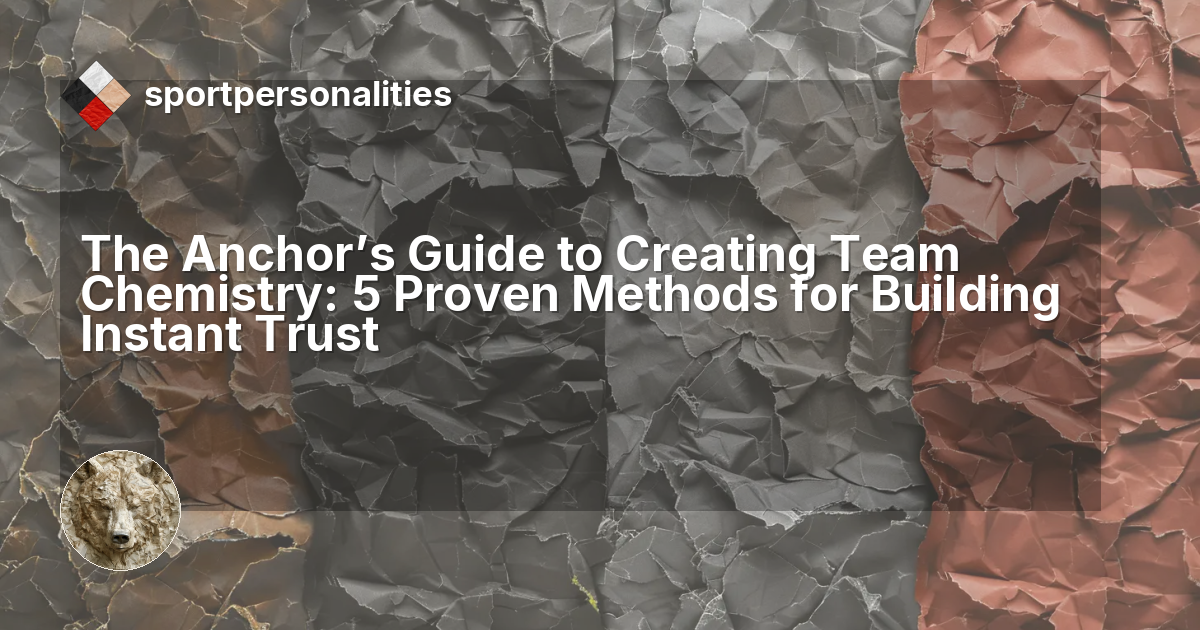Walking into a new locker room for the first time feels like navigating foreign territory. The inside jokes you don't understand, the established rhythms you haven't learned, the unspoken hierarchies that everyone else seems to know by heart. For athletes who thrive on connection and collaboration, this moment can feel particularly isolating.
You watch teammates who've played together for years communicate with just a glance. They know exactly when to push each other and when to offer support. Meanwhile, you're still figuring out who prefers direct feedback and who needs encouragement wrapped in gentler language. The chemistry that makes great teams unstoppable doesn't happen overnight, but some players seem to accelerate the process naturally.
The Question: How Can Anchors Build Deep Trust and Chemistry With New Teammates Faster?
When natural collaborators join established teams, they face a unique challenge. Their greatest strength lies in creating meaningful connections and fostering team unity, but these qualities need time to develop. The question becomes: how can they build the kind of trust that transforms a group of individuals into a cohesive unit without waiting months for relationships to evolve organically?
The Quick Answer: The Coach's Diagnosis
 The Anchor (ISTC)'s path to instant team chemistry starts with leveraging their natural collaborative instincts, but with intentional focus on five specific trust-building behaviors. These aren't personality changes or forced social interactions. They're strategic applications of existing strengths that create immediate psychological safety and demonstrate reliability.
The Anchor (ISTC)'s path to instant team chemistry starts with leveraging their natural collaborative instincts, but with intentional focus on five specific trust-building behaviors. These aren't personality changes or forced social interactions. They're strategic applications of existing strengths that create immediate psychological safety and demonstrate reliability.
The key insight is this: trust forms through predictable positive interactions, not grand gestures. Anchors who master this approach don't just integrate into existing team dynamics; they elevate the entire group's capacity for connection and performance.
The Deeper Dive: Why the Anchor is Prone to This
The Anchor faces a particular version of the new team challenge because their collaborative nature creates both advantages and obstacles. Their instinct to build consensus and foster team harmony becomes complicated when they don't yet understand the group's existing dynamics.
Consider what happens when an Anchor joins a basketball team mid-season. They naturally want to facilitate better communication between teammates, but they lack the historical context that informs current relationships. They might try to mediate a tension between two players without understanding that this conflict actually motivates both athletes to perform better.
Their strategic mindset also works against them initially. While other personality types might jump into social situations and learn through trial and error, Anchors often analyze team dynamics before acting. This careful observation period, though ultimately valuable, can create distance when teammates interpret it as aloofness or disinterest.
The Anchor's self-referenced motivation system adds another layer of complexity. They're driven by internal standards rather than external validation, which means they might focus on proving their worth through performance rather than relationship building. A soccer midfielder with this approach might demonstrate their tactical knowledge and work ethic perfectly while missing opportunities to connect with teammates on a personal level.
Most significantly, their fear of forced individualistic competition can make them overly cautious about asserting themselves socially. They worry that stepping into leadership roles too quickly might be seen as self-promotion rather than team service. This hesitation, while thoughtful, can slow the natural process of establishing their place within the team hierarchy.
Discover Your Sport Personality
This article explores one of 16 profiles. Find out which one you are and unlock a personalized blueprint for your athletic journey.
Take the Free TestThe Playbook: 5 Proven Methods for Building Instant Trust
Method 1: The Consistency Signal
Trust begins with predictability, and Anchors can establish this immediately through consistent small behaviors. This means showing up the same way every single day, particularly in the details that teammates notice but rarely discuss.
A volleyball player demonstrates this by arriving at the same time before practice, following the same warm-up routine, and offering the same encouraging words to teammates during drills. These patterns signal reliability without requiring deep relationships to develop first. Teammates begin to count on their presence and energy, which forms the foundation of trust.
The key is choosing sustainable behaviors that align with their natural tendencies. An Anchor shouldn't try to become the team comedian if humor isn't their strength. Instead, they might become known for their thoughtful questions during film study or their willingness to stay after practice to work with struggling teammates.
Method 2: The Competence Bridge
Nothing builds trust faster than demonstrated competence, but Anchors can accelerate this process by making their skills immediately useful to others. Rather than waiting for their individual performance to speak for itself, they can actively share their strategic insights and preparation methods.
Imagine a hockey defenseman who notices that teammates struggle with reading opposing power play setups. Instead of keeping their analysis private, they create a simple system for communicating threats during games. When this system leads to successful penalty kills, teammates associate the Anchor with immediate, practical value.
This approach works because it demonstrates competence while serving the team's interests. The Anchor isn't showing off; they're solving problems. This distinction matters enormously in team sports, where individual brilliance can create resentment if it doesn't translate to collective success.
Method 3: The Curiosity Connection
Anchors can bypass the typical small talk phase of relationship building by asking teammates questions that reveal genuine interest in their perspectives and experiences. This isn't networking; it's authentic curiosity about what motivates and challenges other players.
A baseball catcher might ask a veteran pitcher about the mental side of closing games or inquire how a rookie outfielder approaches hitting in clutch situations. These conversations serve multiple purposes: they show respect for teammates' expertise, provide valuable learning opportunities, and create personal connections based on shared competitive interests.
The Anchor's natural strategic thinking makes them excellent at asking questions that teammates actually want to answer. They can identify what each player takes pride in and create conversations around those topics. This approach feels natural because it serves their own learning goals while building relationships.
Method 4: The Pressure Share
One of the fastest ways to build trust is to voluntarily take on challenges that help teammates succeed. Anchors can identify pressure points within the team and position themselves to absorb some of that stress, particularly in areas where their strengths align with team needs.
Consider a tennis doubles player who notices their partner struggles with net play under pressure. Instead of avoiding those situations, the Anchor might adjust their positioning to create more favorable net opportunities for their teammate. They're using their strategic thinking and steady performance to reduce their partner's anxiety while improving team results.
This method works because it demonstrates commitment to shared success over individual statistics. Teammates recognize when someone is making their job easier, and this recognition translates quickly into trust and loyalty.
Method 5: The Feedback Loop
Anchors can accelerate relationship building by creating systems for ongoing communication that help teammates understand their intentions and preferences. This might involve brief conversations after practices or games where they share observations and invite input.
A soccer midfielder might establish a routine of checking in with defenders about communication preferences during games or asking forwards about their preferred timing for through balls. These conversations accomplish two things: they show respect for teammates' expertise and they help prevent misunderstandings that can damage trust.
The key is making these feedback loops feel natural rather than forced. The Anchor's collaborative nature makes this approach authentic, but they need to initiate the conversations rather than waiting for teammates to come to them.
Turning a Weakness Into a Cue for Action
The Anchor's thoughtful approach to team integration doesn't have to mean slow relationship building. Their natural collaborative instincts and strategic mindset can actually accelerate trust development when applied intentionally through these five methods.
The transformation happens when they recognize that building team chemistry is itself a strategic challenge worthy of their analytical attention and collaborative energy. Instead of waiting for relationships to develop naturally, they can treat trust building as a skill to master and a problem to solve.
When Anchors embrace this active approach to team integration, they don't just find their place within existing team dynamics. They elevate the entire group's capacity for communication, mutual support, and collective performance. Their patient, strategic nature becomes the foundation for deeper team chemistry rather than an obstacle to overcome.
The teams that benefit from this approach often discover that the Anchor's systematic method of building trust becomes a model for how they welcome future new members. What starts as one player's integration strategy evolves into a team culture that prioritizes connection and psychological safety for everyone.
This content is for educational purposes, drawing on sport psychology research and professional experience. I hold an M.A. in Social Psychology, an ISSA Elite Trainer and Nutrition certification, and completed professional training in Sport Psychology for Athlete Development through the Barcelona Innovation Hub. I am not a licensed clinical psychologist or medical doctor. Individual results may vary. For clinical or medical concerns, please consult a licensed healthcare professional.



